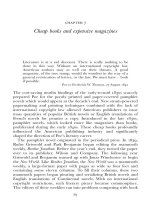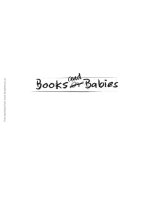Cheap books and expensive magazines
Bạn đang xem bản rút gọn của tài liệu. Xem và tải ngay bản đầy đủ của tài liệu tại đây (64.92 KB, 11 trang )
chapter 7
Cheap books and expensive magazines
Literature is at a sad discount. There is really nothing to be
done in this way. Without an international copyright law,
American authors may as well cut their throats. A good
magazine, of the true stamp, would do wonders in the way of a
general revivication of letters, or the law. We must have ± both
if possible.
± Poe to Frederick W. Thomas, 27 August 1842
The cost-saving muslin bindings of the early-to-mid 1830s scarcely
prepared Poe for the poorly printed and paper-covered pamphlet
novels which would appear at the decade's end. New steam-powered
papermaking and printing techniques combined with the lack of
international copyright law allowed American publishers to issue
mass quantities of popular British novels or English translations of
French novels for pennies a copy. Introduced in the late 1830s,
pamphlet novels, which looked more like magazines than books,
proliferated during the early 1840s. These cheap books profoundly
in¯uenced the American publishing industry and signi®cantly
shaped the direction of Poe's literary career.
The pamphlet novel originated in the periodical press. In 1839,
Rufus Griswold and Park Benjamin began editing the mammoth
weekly, Brother Jonathan. Before the year's end, they turned the paper
over to its publisher, Wilson and Company. The following year
Griswold and Benjamin teamed up with Jonas Winchester to begin
the New World.LikeBrother Jonathan,theNew World was a mammoth
weekly, a large-format paper with pages as wide as four feet and
containing some eleven columns. To ®ll their columns, these two
mammoth papers began pirating and serializing British novels and
English translations of Continental novels. With no international
copyright restrictions, such literary piracy became commonplace.
The editors of these weeklies ran into problems competing with book
87
publishers, however, who also pirated British novels. Serial publi-
cation took time whereas the book publishers could rush a complete
volume into print as soon as the ®rst copies of the work to be pirated
arrived from Europe. Brother Jonathan and the New World rose to the
competition and began issuing complete novels as ``extras.'' The
publishers sent men to meet arriving steamships before they docked
in order to obtain the earliest possible copies of the newest English
novels. Employing numerous typesetters and working them all day
and through the night, they could have a complete work set in type,
printed, and on the streets within twenty-four hours.
1
Closely printed in small type on inexpensive paper with multiple
columns per page and issued in paper covers, these pamphlet novels
reduced the triple-decker Victorian novel to a volume of perhaps
thirty to seventy pages which sold from 6
1
4
cents to a quarter. During
his second visit to the United States in the mid 1840s, British geologist
Charles Lyell found that the same works which, in England, required
a signi®cant amount of money to purchase could be had for pennies
in America. So many people read pamphlet novels that widespread
ocular damage was feared. Lyell further wrote, ``Many are of opinion
that the small print of cheap editions in the United States, will
seriously injure the eyesight of the rising generation, especially as
they often read in railway cars, devouring whole novels, printed in
newspapers, in very inferior type.''
2
The remark re¯ects a common
concern, but advantages in convenience and thrift permitted by these
new formats countered fears of eye injury. As one contemporary
American critic of cheap literature remarked, ``[I]n this country,
there are few words that have so attractive a sound as `cheap.' ''
3
Sold on the street at news-stands and read in such public places as
railway cars, pamphlet novels became part of the visual landscape.
When Nathaniel Hawthorne noticed a train pulling into a small
New England station, for example, he saw several passenger cars,
each ®lled with people ``reading newspapers, reading pamphlet
novels, chatting, sleeping; all this vision of passing life!''
4
Their
garish paper covers made pamphlet novels all the more noticeable in
public. Evert Duyckinck called them the ``crimson and yellow
literature'' ± the ``hues of blood and the plague.''
5
One could
scarcely walk through any crowded public place in the early 1840s
without noticing these brightly covered pamphlets clutched in hand
or tucked under arm and therefore being reminded of the ubiquity
of foreign literature in America.
88 Poe and the printed word
All the popular European authors of Poe's day made it into cheap
American editions. Many of the sentimental, picaresque works of the
French novelist, Charles-Paul de Kock, for example, were available
in cheap English translations during the early 1840s. Sister Anne was
published in 1843 as a Brother Jonathan extra. The following year, The
Six Mistresses of Pleasure and The Student's Girl appeared in cheap
editions. One vociferous opponent of cheap literature recalled its
beginnings and harshly criticized the dissemination of such see-
mingly vulgar French literature: ``Dumas, De Kock, and a hundred
others, whose very brains ran to seed with their rank growth, were
vomited forth ubiquitously in all parts of our land. The distorted,
unreal, grotesquely horrible creations of perverted French taste,
became as familiar as Robinson Crusoe.''
6
A reference Poe made to
De Kock in his ®ction re¯ects his disgust with the popular French
author whose works many American readers preferred over native
productions. In ``The System of Dr. Tarr and Professor Fether,'' Poe
named one of the lunatics ``De Kock'': the one who brays like a
donkey.
Another of Poe's references to a popular foreign author whose
works were widely available in cheap American reprints is more
subtle. William Harrison Ainsworth, a contemporary British writer,
enjoyed much popularity among American readers. Finding Ains-
worth's Crichton less than admirable, Poe called it ``a somewhat
ingenious admixture of pedantry, bombast, and rigmarole.''
7
Several
of Ainsworth's books were available as pamphlet novels. The Miser's
Daughter appeared as a Brother Jonathan extra in 1842. Windsor Castle,
An Historical Romance appeared as a New World extra in 1843, and
Modern Chivalry, or, A New Orlando Furioso appeared as a New World
extra in January 1844. For the ``Balloon Hoax,'' published just a few
months after the cheap edition of Modern Chivalry appeared, Poe
made Ainsworth one of the men who crosses the ocean from
England to America. While the presence of a real-life author aboard
the ocean-crossing balloon is usually interpreted as another device
contributingtothestory'svraisemblance, the fact that the author
speci®ed is Ainsworth (instead of, say, Charles Dickens) makes the
story a comment on the swiftness with which mediocre British
literature made its way to America. Much of the narrative is told in
the form of a journal by Monck Mason, another real-life persona
who is the balloon's inventor in the story. Ainsworth's remarks
appear as postscripts to Mason's daily entries. The relationship of
Cheap books and expensive magazines 89
their written comments in the story conveys Poe's idea of the proper
relationship between the two. The popular writer should be sub-
servient to the creative genius.
American authors seldom complained about being outsold by
pirated editions of Scott or Dickens, but as mediocre British writers
became more widely read in America than the ®nest native writers,
the locals had reason to complain. Poe came to believe that the
absence of international copyright law rendered it nearly impossible
for American authors to be remunerated for their literary labors.
8
He directly linked the pamphlet novel ± ``the external insigni®cance
of the yellow-backed pamphleteering'' ± to the lack of international
copyright law.
9
In his private correspondence and published wri-
tings, Poe frequently decried the lack of copyright laws and recog-
nized the damage done to native authors.
While British and translated French books could be had in cheap
editions in the United States, the opposite phenomenon took place
in Great Britain where American books were pirated and published
cheaply. John Cunningham, a Fleet Street publisher, issued several
pamphlet novels printed two columns to the page and known
collectively as the ``Novel Newspaper'' series. Most were reprints of
pirated American novels. The series was intended as a deliberate
counter-campaign against American piracy of British texts, as the
publisher admitted in some prefatory remarks to one of several
James Fenimore Cooper works. Besides Cooper, the series included
many works written by Poe's friends, acquaintances, and kindred
spirits: Robert M. Bird's Hawks of Hawk-Hollow, Charles Brockden
Brown's Wieland, John Pendleton Kennedy's Horse-Shoe Robinson as
well as his RoboftheBowl, Caroline Kirkland's ANewHome,John
Neal's Logan, the Mingo Chief, James Kirke Paulding's Koningsmarke,
and William Gilmore Simms's Confession, or The Blind Heart. Michael
Sadleir lists all of these titles in his excellent study of nineteenth-
century ®ction. He does not mention one additional title, however,
which Cunningham added to the series in 1841: Arthur Gordon Pym:
Or, Shipwreck, Mutiny, and Famine.
10
Cunningham's revised title
emphasized the most sensational qualities of Poe's work and thus
made it all the more suitable for the cheap print trade.
Other Poe works were also pirated and issued in cheap British
editions. ``The Facts of M. Valdemar's Case,'' a work Philip Pen-
dleton Cooke called ``the most damnable, vraisemblable, horrible,
hair-lifting, shocking, ingenious chapter of ®ction that any brain ever
90 Poe and the printed word
conceived,''
11
appeared in the American Review in late 1845, and some
took it for a genuine example of mesmerism. Short and Co., a
London ®rm, pirated the work and reprinted it as Mesmerism ``in
articulo mortis'': An Astounding and Horrifying Narrative, Shewing the
Extraordinary Power of Mesmerism in Arresting the Progress of Death,a
sixteen-page pamphlet which sold for threepence. ``The Gold-Bug''
also appeared as a cheap London pamphlet. Published by A. Dyson,
who generally published pamphlets treating contemporary economic
issues, TheGoldBugwas the ®rst number of what Dyson projected to
be a lengthy series, ``The Thousand-and-One Romances.'' Using
The Gold Bug to lead off a literary series, Dyson revealed his
con®dence in the strength of Poe's work among British readers. The
failure of the series suggests that Dyson may have been more
forward-thinking than the British reading public. To my knowledge,
``The Thousand-and-One Romances'' began and ended with The
Gold Bug.
12
Respectable publishers who issued the works of native authors
needed a way to compete with the pirated imports. Yet there was no
way they could honor contracts, pay royalties, and still publish book-
length works at prices which could compete with the cheap books.
The commercial success of the pamphlet novel helped perpetuate
the long-standing practice of publishing a long work in separate
parts. This part-by-part publishing had taken place for some
decades, and one of the most famous books in American literature,
Washington Irving's The Sketch Book of Geoffrey Crayon, appeared in
parts in 1819 and 1820. The idea was that once consumers had
acquired all the parts, they could have them handsomely bound
together as a single volume which would make a ®ne addition to
their personal libraries. The publishing industry's eventual adapt-
ation of edition binding should have tolled the death knell for part-
by-part book publication during the early 1830s, but the competition
created by the pamphlet novels helped perpetuate it through the
1840s.
In 1843, Philadelphia publisher William H. Graham issued The
Prose Romances of Edgar A. Poe, a 48-page pamphlet containing ``The
Murders in the Rue Morgue'' and ``The Man that Was Used Up''
which sold for 12
1
2
cents. The work was published as part of Poe's
``Uniform Serial Edition,'' the ®rst of several numbers planned.
13
A
collection of Poe's stories published part-by-part, Graham realized,
had an advantage over novels similarly published, for each part
Cheap books and expensive magazines 91









